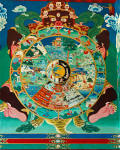Coorg(Kodagu), Karnataka, India
Coorg lies in southwestern Karnataka, at the southern end of the Western Ghats. Its name is probably a corruption of the Kannada kodagu ("steepness"). Its 4,104 sq km area is rugged and hilly with a high rainfall and a climate tempered by its altitude. The thickly forested hills often exceed 5,000 ft. Notable summits, all above 5,300 ft, include Tadramol, Pushpagiri, and Kottebetta. Coorg is drained by the upper Cauvery River and its tributaries, which in legend have some of the life-giving properties of the Ganges. Rice is cultivated on the valley floors. Coffee plantations occupy hillside clearings. Other crops are tea, cardamom, rubber, pepper, and millet. There are orange groves in the south and evergreen timber forest in the west.
Coorg was an independent kingdom from the 9th century. A Hindu dynasty ruled almost continuously from the late 16th century until overthrown by the British in 1834. The region became a province (a state after 1950) of British India and because of its ruggedness was sometimes referred to as the "Wales of India." Administered by the chief commissioner of Mysore from 1881 to 1947, Coorg was absorbed into Mysore in 1953. The main towns are the district headquarters, Madikeri, Somvarpet, Virarajendrapet, and Ponnampet. A local hero is the former Field Marshal in the Indian Army, General KM Cariappa. [Adapted from Encyclopedia Britannica]
|
Madikeri In 1681 Mudda Raja selected the central but inaccessible site of present day Madikeri for the capital of the independent Hindu dynasty of Coorg. A fort built in 1812 by Raja Lingarajendra II and the hilltop Omkareshwara Temple overlook the relatively quiet town. Raja's Seat, a picturesque little garden, commands a panoramic view. [Adapted from Encyclopedia Britannica] |
|||
Tile rooftops (more)  |
On series of ridges at 1200 m  |
View from Raja's Seat  |
Madikeri town square  |
Madikeri fort (1812 CE) ▒  |
Former church, now museum  |
||
| Built by Raja Lingarajendra II  |
Complex near the fort  |
||
 |
Temple tank  |
Temple with tank  |
Temple visitors  |
|
Tibetan Settlements Around Bylakuppe Southwestern Karnataka is also home to the largest Tibetan settlement in India outside the Himalayan belt. Both recent refugees from Tibet and those born elsewhere, live here in a landscape and climate that is a far cry from Tibet but, as one monk pointed out, with one crucial consolation: they live without fear and practice their faith in freedom. With the cross-border migration of thousands of monks in recent decades, India also seems to have emerged as the destination for higher Tibetan Buddhist studies. But unlike most Tibetan settlements in the Indian Himalayas, the monasteries here appear to be larger and more opulent (more ostentatious at any rate). The shiny Namdroling monastery even has gigantic gold-plated statues of Tibetan deities which, in contrast with its own teaching, must provoke awkward questions in the mind of many a visitor. Namdroling Monastery |
|||
Padmasambhava vihara (more)  |
Left (right) of entrance  |
Inside the monastery (more) About the statues: 1, 2 3  |
Garden around monastery  |
Chanting monks (more)  |
Filming monk  |
||
The Golden Temple (more)  |
Pilgrims from Ladakh  |
||
The Golden Temple (more)  |
Inside the Golden Temple (1, 2)  |
Gold-plated Avalokiteshwara  |
Paintings inside (more)  |
|
Sera Je Monastic University |
|||
Monastery building  |
Buddhist temple / university  |
Main entrance  |
 |
|
Sera Mey Monastic University ▒ |
|||
Complex gateway ▒  |
Buddhist temple / university  |
Steps to the main entrance  |
Murals at the front entrance  |
The wheel of samsara  |
An allegorical illustration  |
Gathering hall (more)  |
Praying monk in doorway  |
Butter sculpture  |
An isle in the monastery  |
Monks' residence  |
Village around the monastery  |
|
Sera Thekchenling Lachi Cultural Society |
|||
Main building  |
Assembly hall  |
Painting left of the shrine  |
Painting right of the shrine  |
|
Miscellaneous |
|||
Hardhong Khangtsen monastery ▒  |
Inside the monastery  |
Ngagyur Nyingma Nunnery  |
Monk rolling a gas cylinder  |
Designed in collaboration with Vitalect, Inc. All rights reserved. |








